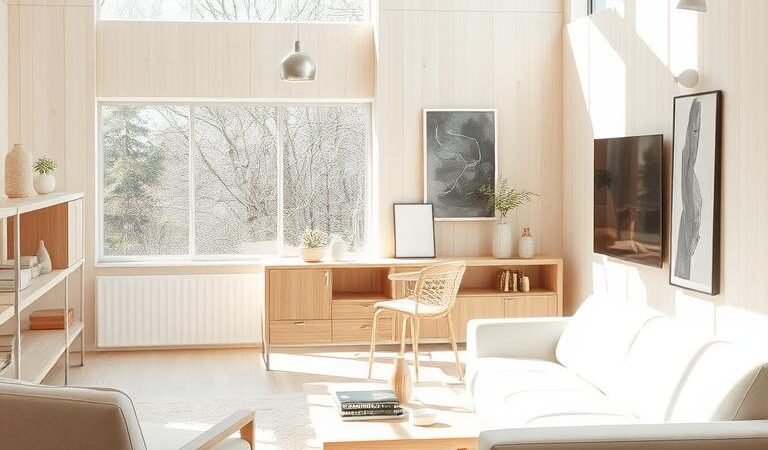Effortless elegance meets practicality in Scandinavian design. This style transforms spaces with airy simplicity, where every element serves a purpose. Natural materials and muted tones create a calming atmosphere, perfect for modern living.
At its core, this approach values functionality without sacrificing beauty. Light-reflecting surfaces and uncluttered layouts enhance a sense of openness. The result? A home that feels both inviting and refreshingly simple.
Discover how to bring this aesthetic into your space. From furniture choices to decor accents, small changes make a big impact. Learn the secrets behind this globally loved style in our guide to Scandinavian interior design.
Key Takeaways
- Focuses on simplicity, functionality, and natural elements
- Uses light-reflecting materials to brighten spaces
- Creates calming environments through thoughtful design
- Combines practicality with visual appeal
- Works well in various home sizes and layouts
Introduction to Scandinavian Minimalism
Rooted in Nordic culture, this design philosophy blends beauty with purpose. It emerged in the 1930s, influenced by Bauhaus principles and Nordic resilience. Unlike stark minimalism, it embraces warmth—think airy rooms with tactile textures.
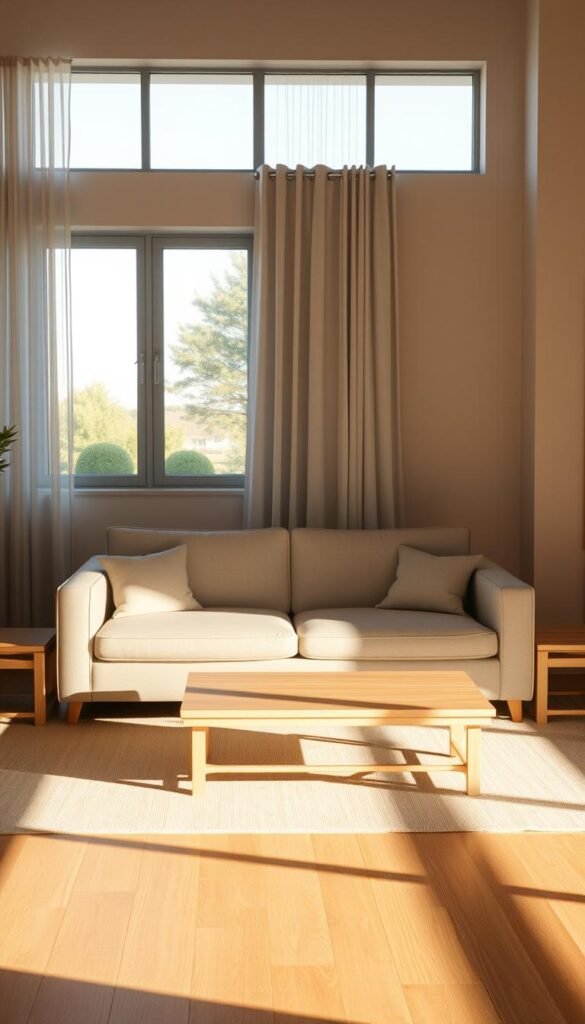
Geographical quirks shaped its DNA. Long winters demanded functional interiors, while midnight sun inspired light-reflecting surfaces. The Swedish concept of lagom—”just right”—guides every choice, from furniture to fabrics.
Cultural Contrasts in Minimalism
| Style | Focus | Materials |
|---|---|---|
| American | Open layouts | Mixed metals, bold hues |
| Japanese | Zen emptiness | Dark woods, paper screens |
| Nordic | Cozy functionality | Light woods, wool, linen |
Pioneers like Alvar Aalto and Arne Jacobsen championed organic curves and durability. Later, IKEA democratized the style, merging affordability with Scandinavian design ethos. Today, it’s linked to sustainability—think renewable materials and energy efficiency.
Studies reveal a fascinating link: Nordic countries top happiness indexes, partly due to thoughtful interior design. Clutter-free space fosters mental clarity, proving this aesthetic is more than decor—it’s a lifestyle.
The Philosophy Behind Scandinavian Minimalism
More than just decor, this approach weaves culture into every corner of the home. It’s a mindset—where every object earns its place through purpose or joy. The Nordic ethos blends functionality with emotional resonance, creating spaces that feel both curated and lived-in.
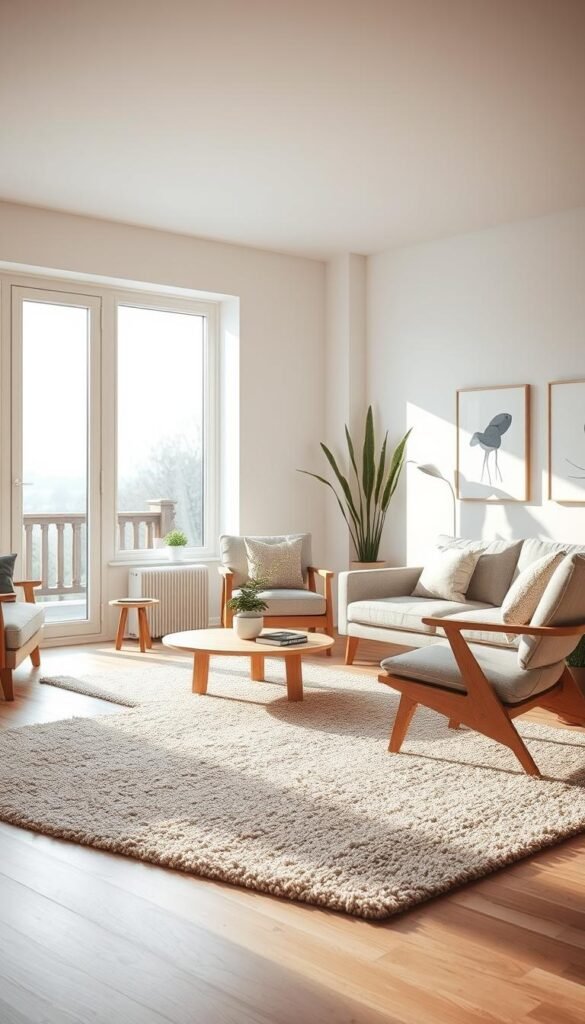
Origins and Cultural Influences
Viking practicality laid the groundwork. Their multi-generational furniture traditions valued durability, a trait still seen in Nordic design today. The 1930s functionalism movement added clean forms, while long winters demanded interiors that combat darkness—think pale walls and open layouts.
The Role of Hygge in Design
Hygge (pronounced hoo-ga) is atmospheric alchemy. Meik Wiking, CEO of Copenhagen’s Happiness Institute, describes it as “cocooning your space in warmth.” Think flickering candles, chunky knits, and nooks for reading. This isn’t just decor—it’s survival strategy for Danish winters.
| Concept | Key Traits | Scandinavian Twist |
|---|---|---|
| Hygge | Cozy intimacy | Organic textures + diffused lighting |
| Lagom | Balance | Neither sparse nor excessive |
| Wabi-sabi | Imperfection | Focuses on patina over flaws |
Simplicity as a Lifestyle
Unlike Marie Kondo’s decluttering, Nordic simplicity embraces space as psychological relief. IKEA’s “Democratic Design” philosophy—affordable, sustainable, beautiful—mirrors Nordic social equality. Brands like Axel Arigato update this ethos with sleek sneakers that marry form and function.
At its core, it’s about reducing noise. Fewer choices mean less fatigue. A 2019 University of Copenhagen study linked uncluttered homes to lower stress levels—proof that this philosophy transcends aesthetics.
Key Elements of Scandinavian Minimalism
Distinctive features create harmony in Scandinavian-inspired spaces. Each component works together to form balanced, inviting interiors. From material choices to spatial planning, these elements transform ordinary rooms into serene retreats.
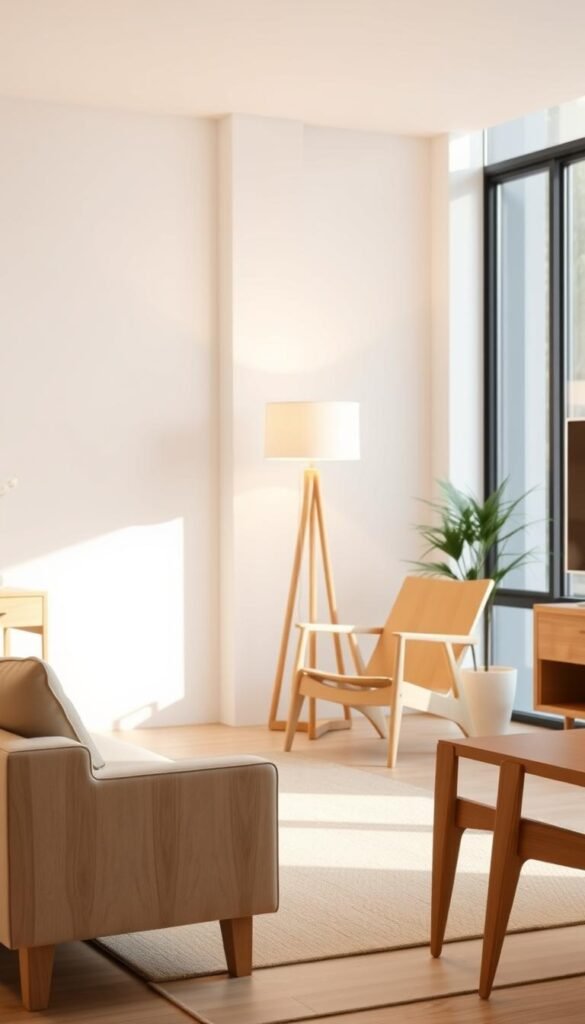
Light Wood Tones
Birch and pine dominate for their pale hues and visible grain. These natural materials reflect sunlight beautifully, combating dark winters. Swedish craftsmen often use soap finishes to maintain brightness as wood ages.
Norwegian treatments favor linseed oil for deeper protection. Both methods preserve the wood’s inherent warmth. The result? Timeless pieces that grow more characterful without losing their airy quality.
Clean Lines and Uncluttered Spaces
Furniture follows the “less but better” philosophy—think Arne Jacobsen’s Egg chair. Negative space acts as a design feature, allowing eyes to rest. Open floor plans enhance visual flow between areas.
- Multi-functional pieces like storage ottomans reduce clutter
- Built-in shelving maintains sleek profiles
- Bang & Olufsen tech integrates seamlessly with minimalist decor
Neutral Color Palettes
Foggy grays and chalk whites form the base of most schemes. These hues mimic Nordic landscapes while maximizing light diffusion. Matte paint finishes prevent glare, creating soft luminosity.
Texture layering adds depth to monochromatic rooms. A wool throw over linen curtains, or a rattan basket beside ceramic vases. This approach keeps spaces interesting without introducing visual noise.
The History of Scandinavian Minimalism
The journey of Nordic design reflects a century of innovation and cultural shifts. What began as practical solutions for harsh climates became a globally admired aesthetic. This history reveals how functionality and beauty merged into an enduring style.
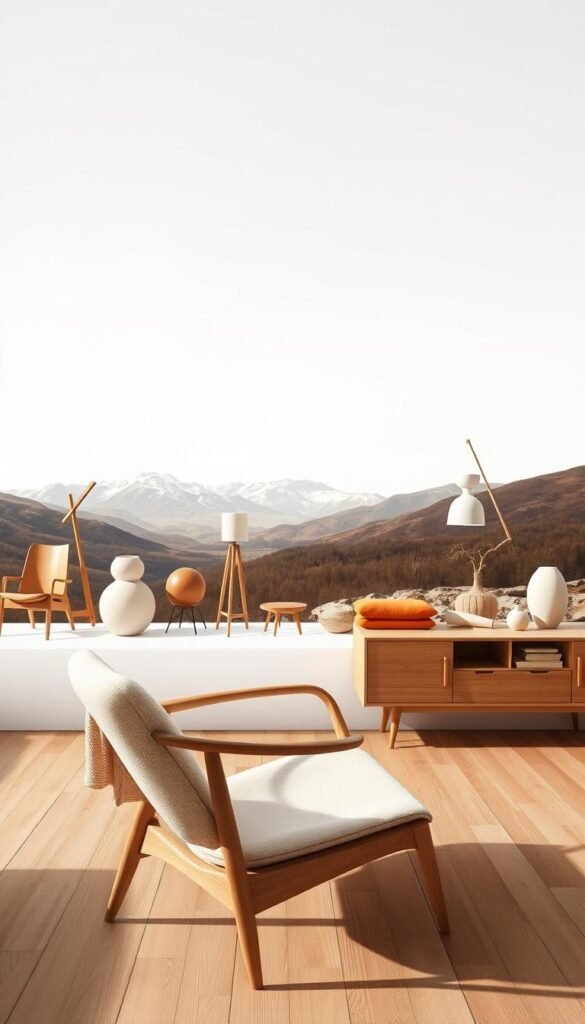
Early Influences and Pioneers
1930s functionalism laid the foundation with its emphasis on clean forms. Arne Jacobsen’s Egg Chair (1958) became an icon—its organic curves demonstrating how design could be both sculptural and comfortable. Post-war America embraced these pieces, seeing them as fresh alternatives to ornate decor.
Danish cabinetmakers pioneered the use of teak during this period. Their workshop traditions emphasized handcrafted quality, setting standards still referenced today. This era proved that simplicity could feel luxurious when executed with precision.
Evolution Over the Decades
The 1970s oil crisis sparked material innovations—plywood replaced solid wood in many pieces. Designers began experimenting with molded plastics and tubular steel. These changes made quality furniture more accessible without sacrificing the core philosophy.
Digital lifestyles brought new considerations in the 2000s. Spaces needed to accommodate technology while maintaining serenity. Built-in charging stations and hidden cable management became subtle features in otherwise classic pieces.
Modern Interpretations
Contemporary creators like Øyvind Wyller reimagine public spaces with modular systems. Their work shows how modern needs shape timeless principles. Gender-neutral furniture and adaptable tiny home solutions continue this evolution.
Looking ahead, sustainability drives innovation. Recycled materials and space-saving solutions dominate new collections. Yet the essence remains—creating harmony between people, objects, and environments through thoughtful design.
Scandinavian Minimalism: Light Wood and Clean Lines
Nordic interiors achieve balance through two signature elements—pale timber and precise silhouettes. These fundamentals work synergistically to create spaces that feel both airy and intentional. The interplay between organic warmth and structured geometry defines this enduring aesthetic.
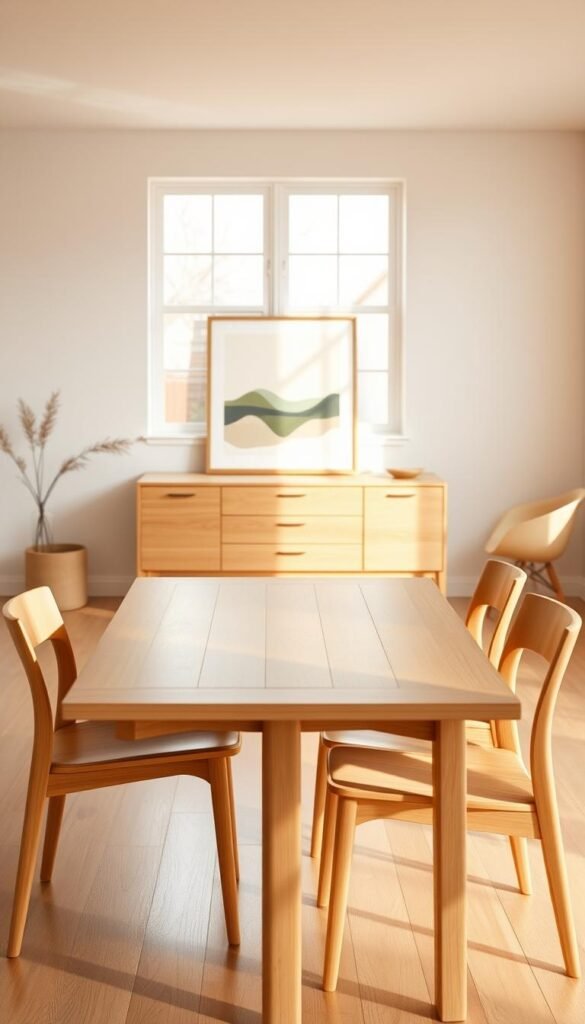
The Science Behind Pale Timber
Honey-toned planks do more than look beautiful—they’re engineered for northern climates. Unlike dark woods that absorb sunlight, species like ash and oak bounce natural light deeper into rooms. Stockholm’s Tapto Architects found these surfaces increase perceived brightness by 40% during winter months.
Finish choices impact longevity and luminosity:
- Oil treatments enhance grain patterns while allowing seasonal wood movement
- Water-based lacquers create velvety matte surfaces with higher light reflectance
- Soap finishes (traditional Swedish method) maintain raw texture without yellowing
Geometry That Guides the Eye
Uninterrupted sightlines form the backbone of this style. A restored 1950s apartment in Gothenburg demonstrates how aligning furniture parallel to walls amplifies spatial flow. Horizontal grain patterns on flooring visually expand narrow areas—a trick Kirsten Sand’s blueprints popularized.
Psychological studies reveal subtle effects:
- Vertical grain subconsciously emphasizes height in low-ceilinged rooms
- Continuous flooring in small spaces reduces visual fragmentation
- Concealed joinery (tongue-and-groove techniques) maintains clean lines
Maintenance preserves these effects. Weekly dusting with microfiber cloths prevents light-diffusing surfaces from dulling. For high-traffic areas, paste wax applied biannually protects against scuffs while enhancing wood’s innate glow.
Furniture Selection for a Scandinavian Home
Curating the right furniture transforms any space into a harmonious retreat. Nordic-inspired interiors prioritize thoughtful selection—where every piece serves a purpose while enhancing visual calm. The balance between form and function creates rooms that feel both intentional and inviting.
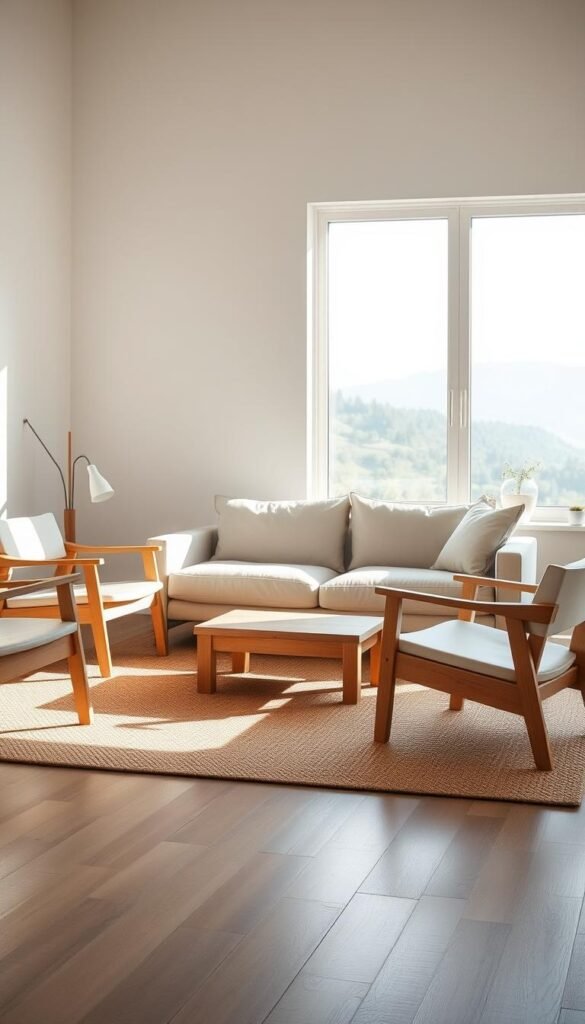
Choosing Multi-functional Pieces
Versatility defines modern Nordic living. Storage beds with built-in drawers maximize small spaces effortlessly. Convertible dining tables expand for guests yet tuck neatly against walls when not in use.
Carl Friedrik’s Palissy Briefcase exemplifies this philosophy—its sleek exterior hides clever compartments. Similarly, HAY’s New Order shelving adapts to books, decor, or media with adjustable modules.
- Functionality meets style in sofa beds with hidden storage
- Nesting tables provide flexible surfaces without clutter
- Bench seating doubles as display space for books or plants
Incorporating Mid-century Modern Classics
Timeless designs like Hans Wegner’s Wishbone Chair showcase perfect proportions. Its curved backrest and tapered legs demonstrate how organic shapes enhance comfort. Authentic teak pieces develop a rich patina over time—unlike veneer alternatives.
| Designer | Iconic Piece | Key Feature |
|---|---|---|
| Arne Jacobsen | Swan Chair | Molded foam upholstery |
| Finn Juhl | Chieftain Chair | Floating seat design |
| Alvar Aalto | Stool 60 | Bent birch legs |
Opting for Neutral Colors and Natural Materials
Pale oak and linen fabrics create soothing backdrops. Danish upholstery favors wool for its durability, while Finnish designs often use papercord for breathability. These materials age gracefully, developing character with use.
For child-friendly options, look for OEKO-TEX certified textiles. They ensure safety without compromising the aesthetic. Minimalist benches in light tones pair perfectly with such fabrics.
Wood moisture content matters—ideal levels between 6-8% prevent warping. This attention to detail ensures pieces last generations while maintaining their effortless charm.
Lighting Strategies in Scandinavian Interiors
Strategic illumination transforms spaces into calming retreats. Nordic homes prioritize natural light while artfully supplementing with layered fixtures. This dual approach creates adaptable environments that shift with daylight hours.
Window treatments play a crucial role. UV-filtering films protect furnishings while maintaining brightness. Seasonal curtain rotations—sheer linen for summer, heavier wool for winter—balance privacy and luminosity.
The best solutions address both practicality and mood. From candlelit evenings to sun-drenched mornings, every lighting scenario enhances the space intentionally.
Maximizing Natural Light
Northern homes treat windows as precious assets. Reflective surfaces like matte white walls amplify incoming sunshine. Strategic mirror placement bounces light into darker corners without glare.
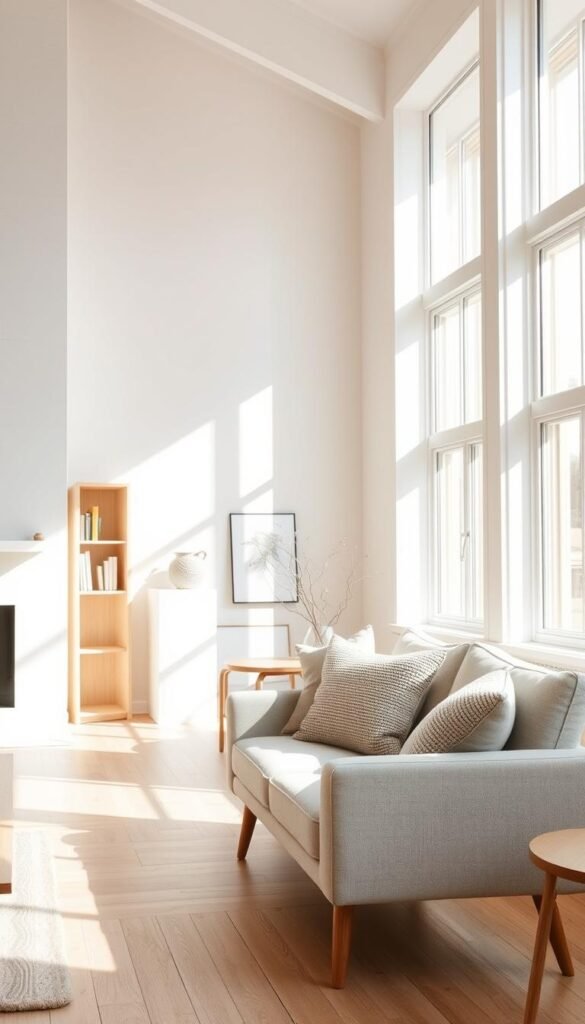
- Angled shelving that doesn’t block window sightlines
- Frosted glass partitions for privacy without sacrificing brightness
- Low-profile furniture that avoids casting shadows
Layered Lighting Techniques
After sunset, a three-tier system maintains ambiance. General overheads provide baseline illumination, while task lights focus on work areas. Accent lighting highlights architectural features or artwork.
Smart bulbs allow temperature adjustments:
- 4000K for morning brightness
- 2700K for evening warmth
- Circadian-friendly transitions that mimic daylight cycles
Choosing the Right Fixtures
Iconic designs like Louis Poulsen’s PH lamps diffuse light beautifully. Their layered shades eliminate glare while directing illumination downward. For reading nooks, adjustable arm lamps offer focused task lighting.
| Fixture Type | Best Use | Designer Example |
|---|---|---|
| Pendant | Dining areas | Paavo Tynell’s “Snowflake” |
| Track | Gallery walls | Gubi’s Multi-Lite |
| Floor | Reading corners | Anglepoise Original 1227 |
Finish matters too. Brushed metals reduce glare, while matte ceramic shades soften brightness. The right combination makes any space feel both functional and inviting.
Textiles and Accessories in Scandinavian Design
Soft fabrics and thoughtful accents bring warmth to streamlined spaces. These elements add tactile richness while maintaining visual calm. From cloud-like sheepskin rugs to hand-thrown pottery, every detail enhances both comfort and style.
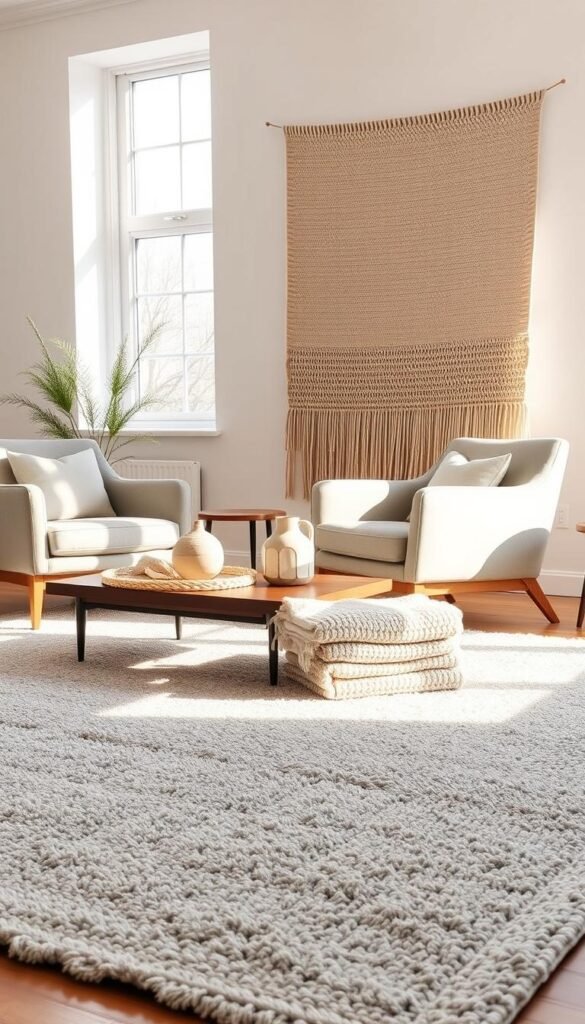
Embracing Cozy Textures
Layering is key for inviting interiors. Start with a base of crinkled linen curtains—their relaxed drape softens sharp angles. Add weight with felted wool throws, known for their sound-absorbing qualities in open-plan rooms.
Sheepskin requires simple care:
- Shake gently outdoors weekly
- Spot clean with mild soap and cold water
- Brush fibers against the grain to maintain fluffiness
Selecting Minimalist Accessories
Marimekko’s bold botanical prints energize neutral backdrops. Pair them with hand-blown glass vases—their irregular bubbles catch light beautifully. For tablescapes, mix matte stoneware with polished ceramics to create depth.
Seasonal swaps keep spaces fresh:
| Season | Textile | Accessory |
|---|---|---|
| Winter | Chunky knit cushions | Brass candle holders |
| Summer | Breezy cotton slips | Woven seagrass trays |
Using Greenery to Add Life
Snake plants thrive in low light, purifying air silently. For beginners, try propagating Swedish ivy—simply snip a stem and place in water. Cluster 3-5 pots at varying heights for dynamic greenery displays.
Best low-maintenance options:
- ZZ plant (tolerates neglect)
- Pilea peperomioides (easy to propagate)
- Air plants (no soil needed)
These living accents bridge indoor and outdoor worlds effortlessly. Their organic shapes complement the clean lines of Nordic design while boosting well-being.
Creating a Scandinavian-inspired Space
Thoughtful curation turns any interior into a serene retreat with purpose-driven aesthetics. This approach balances visual calm with everyday functionality, transforming how you experience your home. Whether starting fresh or refining existing decor, these principles adapt to various layouts and lifestyles.
Decluttering Your Home
The 30-day minimalist challenge simplifies editing possessions. Remove one item on day one, two on day two, continuing through the month. This gradual method prevents overwhelm while creating noticeable space improvements.
For faster results, try the 5-step method:
- Sort by category (clothes, books, decor)
- Evaluate each item’s purpose and joy factor
- Designate zones for keep, donate, and discard
- Organize remaining items with intentional placement
- Maintain with weekly 15-minute tidy sessions
Selecting a Neutral Color Palette
Farrow & Ball’s Scandinavian Whites collection offers nuanced options. “All White” provides crisp brightness, while “Pointing” adds subtle warmth. These hues create adaptable backdrops for natural materials and textured accents.
Muuto’s color system demonstrates effective pairings:
| Base | Accent | Effect |
|---|---|---|
| Soft Gray | Dusty Blue | Calming |
| Warm Beige | Terracotta | Inviting |
| Chalk White | Forest Green | Fresh |
Incorporating Natural Materials
Stone accent walls add organic texture without visual weight. Thin slate tiles installed with minimal grout lines create sleek surfaces. For floors, consider radiant heating beneath limestone or porcelain planks—comfort meets design.
Rental-friendly alternatives include:
- Peel-and-stick wood veneer panels
- Removable grasscloth wallpaper
- Jute area rugs that define zones
Entryways benefit from woven baskets (storage) and matte black hooks (organization). These solutions maintain the aesthetic while addressing practical needs.
Practical Tips for Maintaining a Minimalist Home
A serene home starts with intentional habits. Simple routines keep clutter at bay while preserving the calm of your space. These strategies blend Nordic practicality with modern lifestyle needs.
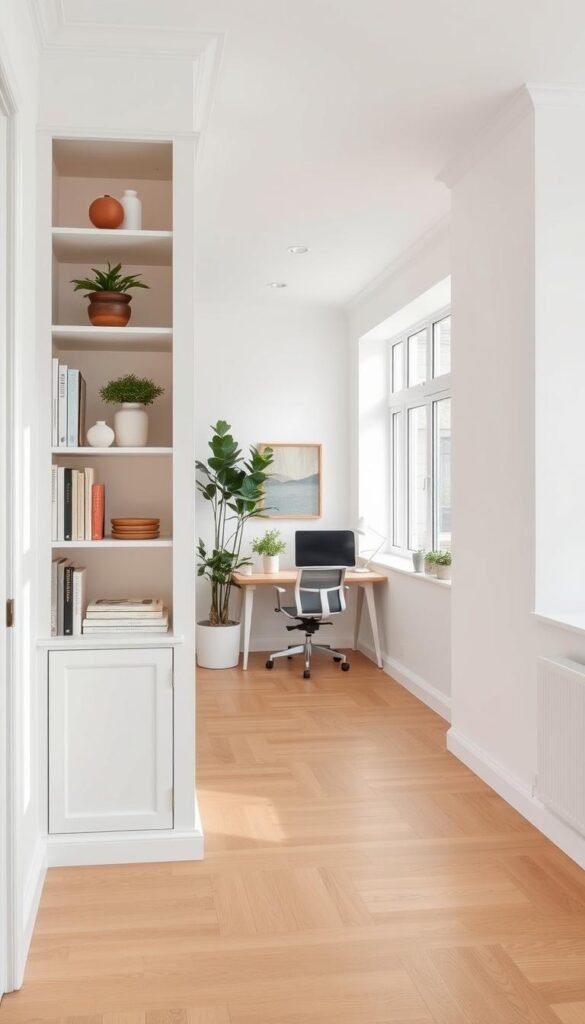
Daily Habits for Lasting Order
The 10-minute tidy-up transforms maintenance into mindfulness. Focus on high-traffic zones first—kitchen counters, entryways, and coffee tables. Keep supplies like microfiber cloths and baskets within reach.
Effective systems prevent accumulation:
- Designated drop zones for keys, mail, and bags
- Nightly surface reset before bedtime
- Immediate decision-making for new items
Seasonal Refresh Without Excess
Rotate textiles and accents quarterly to maintain visual interest. Lightweight linen replaces wool throws in summer, while darker cushions add warmth in winter. This approach keeps your decor feeling current without storage overload.
| Season | Textile Swap | Color Palette |
|---|---|---|
| Spring | Cotton slipcovers | Mint + oatmeal |
| Fall | Felted wool throws | Rust + cream |
Art rotation follows nature’s cycles—botanical prints in spring, abstract landscapes in winter. Try the budget-friendly seasonal update approach for cohesive transitions.
Smart Systems for Every Space
The “one in, one out” rule maintains equilibrium. For every new purchase, donate or recycle a similar item. Swedish brands like Eco by Sonya offer concentrated cleaners that reduce cabinet clutter.
Furniture arrangement follows sunlight patterns—move seating toward windows in winter, create airflow in summer. These subtle shifts renew your space without new acquisitions.
Conclusion
Harmony in design emerges when purpose meets beauty—a principle at the heart of Nordic-inspired spaces. This style thrives on balance, where airy simplicity and intentional geometry foster both comfort and clarity.
Rooted in Viking durability yet refined for modern living, the philosophy champions functionality. Brands like Carl Friedrik embody this with lifetime warranties, proving sustainability needn’t sacrifice elegance.
Begin with small, mindful changes: a decluttered shelf, a handcrafted stool. Mix high-investment staples with affordable accents. Let your space evolve organically, reflecting personal needs and nature’s rhythms.
Ultimately, this approach isn’t about rigid rules—it’s crafting havens that uplift and endure. For deeper inspiration, explore our curated guides on mindful interiors.
